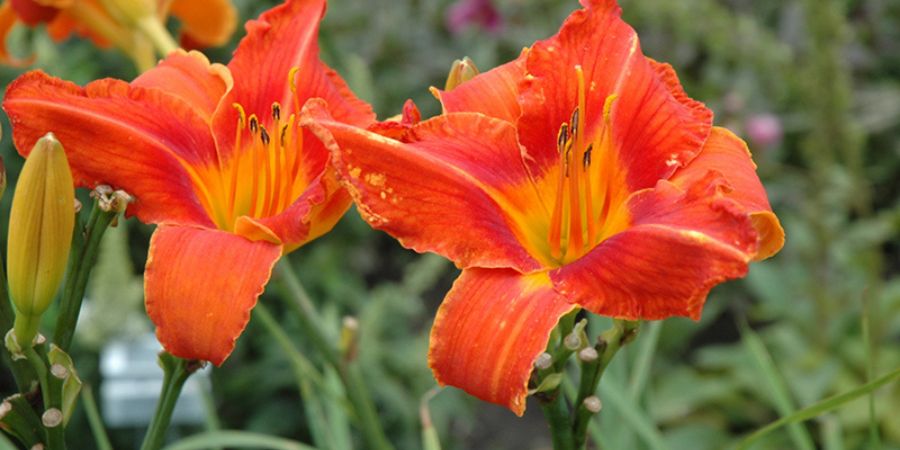Types of Lilies
Asiatic Lilies
Asiatic lilies are known for their bright, vibrant colors and late spring/early summer blooming. They are perennials and easy to grow and less fragrant, making them perfect for those who prefer low-maintenance plants.
Oriental Lilies
Oriental lilies boast large, spectacular blooms and a strong fragrance. These stunning flowering bulbs bloom after Asiatic lilies, continuing the lily parade in the landscape well into the season. Growing oriental lily plants is fairly easy provided you have a well prepared site for bulbs, plenty of sun and good drainage.
Trumpet Lilies
Aurelian, or trumpet, lilies bloom midsummer and are known for their huge, trumpet-shaped blossoms and impressive height. They’re a great addition to any garden.
Martagon Lilies
Martagon lilies have unique downward-facing, turk’s cap-shaped flowers and are more tolerant of shade compared to other varieties. Martagon lilies have slender stems that grow up to 5 feet tall and bear clusters of fragrant blooms from mid-summer through early fall. Each lily flower has six pointed petals arranged around a central cup-shaped structure called the corona, which gives the flower its distinctive turban shape.
LA Hybrids
A cross between Asiatic and Longiflorum lilies, LA Hybrids combine the best traits of both, offering a wide range of colors and robust growth. They also have the heat tolerance and colors of the Trumpet & Aurelian Hybrids.
Visit Applewood Nursery & Landscape Supply, Your One-Stop Landscape Shop!
How to Grow Lilies
Planting Time
The best time to plant lily bulbs is in the fall or early spring.
Soil Requirements
Lilies thrive in well-drained, slightly acidic to neutral soil (pH 6.5-7.0). Avoid heavy clay or waterlogged soil to prevent bulb rot.
Location
Choose a spot with full sun to partial shade. Lilies prefer at least 6 hours of sunlight per day for optimal growth. Check the label for the variety you’re planting to know what kind of sun will work.
Planting Depth and Spacing
Bulb Depth
Plant the bulbs 6-8 inches deep, with the pointed end facing up.
Spacing
Space the bulbs 8-12 inches apart to ensure they have enough room to grow and for adequate air circulation.
Watering and Fertilizing
Watering
Keep the soil consistently moist, especially during dry periods. Avoid overwatering to prevent waterlogging.
Fertilizing
Apply a balanced fertilizer, such as 10-10-10, in early spring and again when the flowers bloom. This will provide the necessary nutrients for healthy growth and vibrant blooms.
Visit Applewood Nursery & Landscape Supply, Your One-Stop Landscape Shop!
Mulching and Weeding
Mulching
Apply a 2-3 inch layer of mulch around the lilies to retain moisture and suppress weeds. Applewood Nursery & Landscape Supply has a variety of mulches to suit your needs.
Weeding
Keep the area around the lilies weed-free to reduce competition for nutrients and water. You can explore hand weeding, hoeing, weed fabric, and many other options to keep the weeds under control.
Pests and Diseases
Pests/Animals
Lilies can be affected by aphids, lily beetles, and slugs. Regular inspection and the use of insecticidal soap can help manage these pests. Rabbits and deer also like to snack on lilies.
Diseases
Common diseases include botrytis (gray mold) and basal rot. Ensure good air circulation and avoid overhead watering to prevent these fungal diseases.
Support and Staking
Support
Tall lily varieties may require staking to prevent them from falling over, especially in windy conditions.
Staking
Use stakes or plant supports and tie the stems loosely to avoid damaging them.
Post-Bloom Care
Deadheading
Remove spent flowers to prevent the plant from expending energy on seed production.
Cutting Back
Allow the foliage to die back naturally to help the bulb store energy for the next growing season. Cut back the stems to the ground in late fall or early spring.
Propagation and Division
Bulb Division
Divide the bulbs every 3-4 years in the fall to maintain healthy growth and increase your lily population.
Scaling
Propagate lilies from scales, which are the layers of the bulb. This method is more advanced but can be very rewarding for increasing your stock.
Final Tips for Growing Lilies
By following these guidelines, you can enjoy a garden full of beautiful lilies that will bloom year after year. Visit Applewood Nursery & Landscape Supply for all your gardening needs, including high-quality lily bulbs, fertilizers, and gardening tools. Our experts are always here to help you create the garden of your dreams.

